The new crosswalk will be a Pedestrian Crossover (PXO) based on new designs recently approved by the Ontario Ministry of Transportation.
By Ryan McGreal
Published October 15, 2015
Last week, Ward 1 Councillor Aidan Johnson announced on Twitter that the City plans to install a new controlled pedestrian crossing at the corner of Queen and Herkimer Streets in the first half of 2016. This will not be a signalized crosswalk like those the city recently installed at Hunter/MacNab and Caroline/Herkimer. Rather, it will be a button-activated pedestrian crossover (PXO) - the first PXO the City has installed in more than a decade.
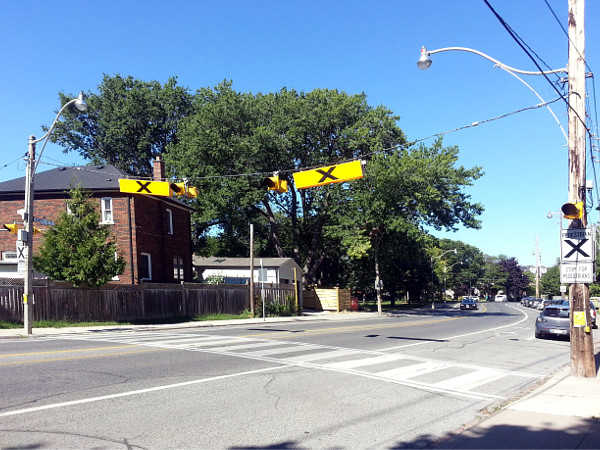
Old-style PXO at Orchard Park in Toronto (RTH file photo)
For years, the City's policy has been not to install PXOs, which are common in Toronto and other Ontario cities, citing research that they are more dangerous than crosswalks that are controlled by standard traffic signals.
According to a 2012 email from Steve Molloy, a Transportation Manager in the Public Works Department, "Toronto has been slowly eliminating their PXO's as they do not have a good safety record due to poor compliance by motorists and the false sense of security they provide to pedestrians."
Instead, the City would install signalized crosswalks, in which a pedestrian button-press would trigger a standard traffic signal to turn yellow and then red before deploying a walk signal. This design is a lot more expensive than a PXO, so the City could not afford to install as many. Before Councillors had access to their area rating capital levy to spend on crosswalks, the City installed almost no crosswalks for a decade.
In response to the poor safety record of old-style PXOs, the Ontario Government has come up with a new design that increases their visibility to motorists and makes the intent - a safe crossing for a pedestrian - more obvious.
The new design has been codified in the latest edition of the Ontario Traffic Manual, which the Ontario Government recently adopted. Book 15 [PDF] of the Manual, which covers Pedestrian Crossing Facilities, specifies several new PXO designs for different street configurations.
According to David Ferguson, a Transportation Manager at Public Works, staff are considering installing a PXO across Queen from the west side to the island, and then two more PXOs connecting the island to the northeast corner and the southeast corner.
The crossing from the west side to the island is expected to be a Type B PXO, midblock across a two-lane, one-way street:
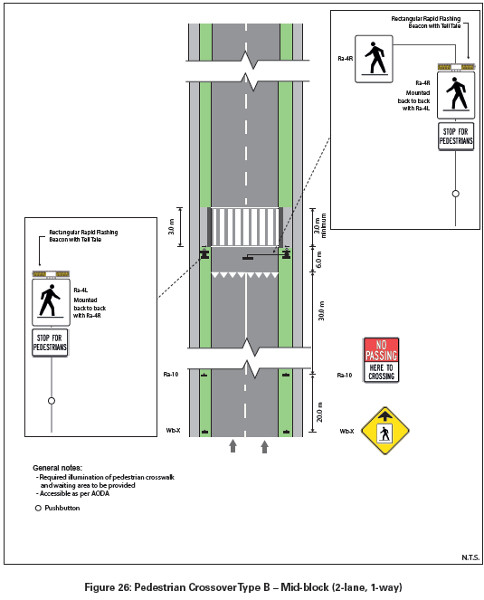
Pedestrian Crossover (PXO) Type B, midblock across a two-lane, one-way street (Image Credit: Ontario Traffic Manual, Book 15, June 2014)
The crossings from the island to the east side are expected to be Type D PXOs, turn channel from island to sidewalk:
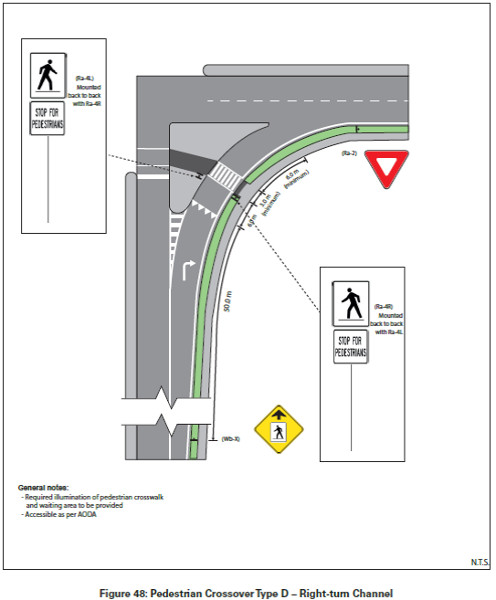
Pedestrian Crossover (PXO), Type D, turn channel (Image Credit: Ontario Traffic Manual, Book 15, June 2014)
Ferguson stresses that staff are still at the planning stage and this is currently a conceptual design that will need to be finalized before the crosswalk is installed in the new year.
He also noted that staff plan to install a PXO at Queen and Aberdeen, an intersection that also has an island and a turn channel for southbound vehicles turning right onto Aberdeen.
Staff will be presenting a Road Safety Report to the Public Works Committee in December that will include more information about the City's new PXO installation program, which will include an education component for drivers who may not be accustomed to the new PXO designs.
It is exciting to see the city move ahead with this new pedestrian crosswalk. For years, Queen Street has been a poster child for the City's destructive impulse to sacrifice urban neighbourhoods on the altar of vehicle traffic flow.
The street is three lanes wide, all one-way southbound, with very few safe places for pedestrians to cross between Main Street and Aberdeen Avenue despite high residential population densities on and around the street.
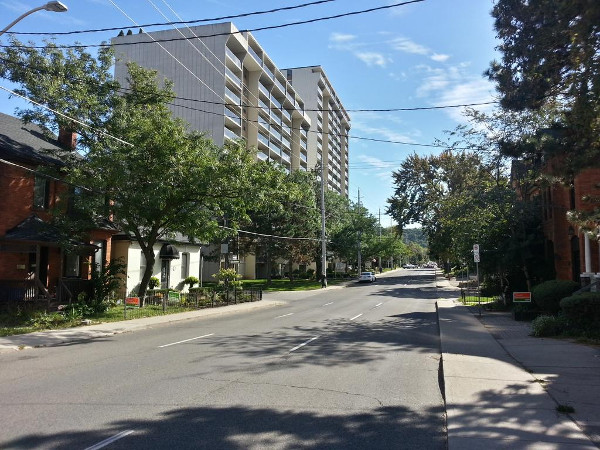
Queen Street South
The street has been plagued with serious collisions involving pedestrians who sustained serious injuries as a result.
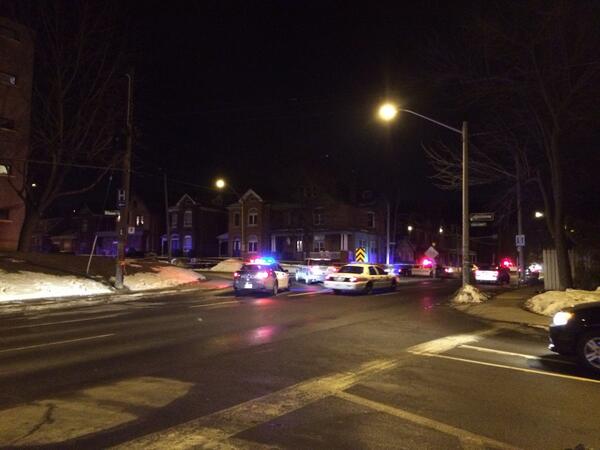
Police cruisers at the site of a collision at Queen and Herkimer, March 7, 2014 (Image Credit: Andrew Spearin)
Last year, in response to the collisions, the City conducted a safety review and identified a number of quick, easy changes that could improve the street, including painting new ladder crosswalks at key intersections and lengthening the crossing time for pedestrians at signalized crosswalks.
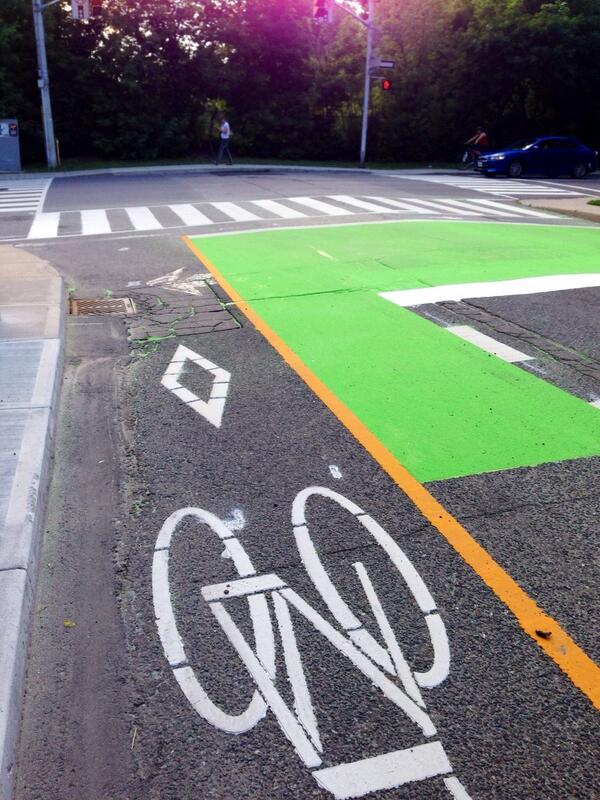
Ladder crossing at Hunter and Queen (RTH file photo)
The intersection of Queen and Herkimer is particularly unpleasant for pedestrians. Queen transitions from a three-lane, one-way street north of Herkimer to a four-lane, two-way south of Herkimer, while Herkimer west of Queen is slightly north of Herkimer east of Queen.
Both the northbound left and southbound right lanes of Queen turn into slip channels for vehicles turning east onto Herkimer, allowing drivers to make the turn without slowing down very much. A small triangular island occupies the leftover space.
The intersection is currently uncontrolled but carries a lot of pedestrian traffic. Aside from the island, which serves as a "pedestrian refuge", the crossing is difficult and feels highly unsafe.
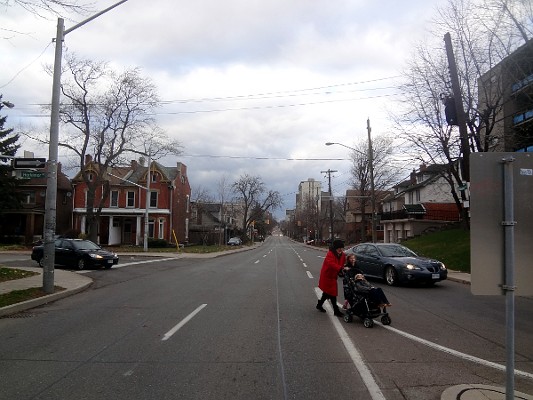
Looking north on Queen from Herkimer (RTH file photo)
For years, the City resisted installing any kind of pedestrian improvements at Queen and Herkimer, so it is very exciting to see this new initiative from Public Works. We look forward to seeing the final design and implementation early next year.
By Pxtl (registered) - website | Posted October 15, 2015 at 11:44:13
I've said this before, but I hope the city doesn't use this later to block a possible 2-way conversion of Queen. I'm happy to see a crosswalk come into a place that needs it, but I'm worried we're solving the wrong problem. That should be a normal intersection with a normal 2-way Queen Street and normal traffic lights.
By Stephen Barath (anonymous) | Posted October 15, 2015 at 12:48:56
It's great news that there are more affordable options, which should hopefully mean they will be deployed in more locations. I'm very curious as to how well compliance will be, especially at the start- I can't help but feel that many motorists will ignore these to begin with. Absent a redesign of the street that encourages different behaviour, I think enforcement (with a view to education) should be stepped up for a period after implementation. I have noticed that drivers in these parts regard pedestrian-activated lights different from "regular" traffic lights, and are more willing to run a red at them. (I'm thinking specifically of Aberdeen and Kent and Aberdeen and MacDonald when I write this.)
You're right that this is a terrible place for human beings, so anything will be welcome. I'm going to curb my enthusiasm for how well these will work, but here's hoping.
By CharlesBall (registered) | Posted October 15, 2015 at 14:06:18
As long as there is a 10-20 second delay on the button, this is a great idea particularly north/south on the east side.
By mdrejhon (registered) - website | Posted October 16, 2015 at 11:37:07 in reply to Comment 114261
Some education may be needed for those not aware that this is actually deployed (it is!), as not everyone is familiar with parlance (e.g. PXO):
Did you know that some pedestrian crossings (more common in other parts of the world than Canada, alas) use standard traffic lights -- but are permanently green until immediately activated by pedestrians? These are the best types, they activate almost immediately for pedestrians (usually), they use standard traffic lights with good compliance by motorists.
If the "permanent green until pedestrian activated" light has been staying green for a long time (e.g. minutes), there's no reason why a pedestrian crosswalk button shouldn't immediately activate.
Immediate activation means instantly causing green to go yellow-then-red -- Before the pedestrian can safely walk across, it takes only 4-5 seconds (or so) to get the WALK signal. You need time for cars to brake -- the yellow-then-red sequence on a traffic light, followed by a small safety delay (red in all directions) followed by a green (or WALK light) for the pedestrians. The standard time between green light followed by green light in the cross direction, is approximately 5 seconds (for the yellow-red delay, all-red delay, followed by the other green), varying depending on location.
After pedestrians crossed, pedestrians cannot immediately reactivate the traffic light for another, approximately 30 seconds (or another number, e.g. 15, 20, 40). A button press done quickly, will just signal the crossing to do a now-delayed activation right after the minimum-allowed green cycle time for cars.
That way, it doesn't frustrate drivers when there's huge surges of pedestrians (e.g. school end-of-day), as when the traffic light goes back to green for cars, it cannot immediately go back to red for at least a minimum delay (e.g. 30 seconds).
But at other times when there's not many pedestrians, the traffic light for cars is permanently green for many minutes at a time, until instantly becoming yellow on the button press of a pedestrian (for quick pedestrian convenience).
Comment edited by mdrejhon on 2015-10-16 11:49:40
By Stephen Barath (anonymous) | Posted October 16, 2015 at 12:29:04 in reply to Comment 114271
What you're describing- "standard traffic lights activated by pedestrians"- is deployed in Hamilton. PXOs are much less common.
By AnjoMan (registered) | Posted October 15, 2015 at 17:21:50 in reply to Comment 114261
I don't understand the need for a delay. Whether the crosswalk activates immediately or waits 20 seconds it will have the same effect - drivers will see the lights come on and will stop to let the pedestrian cross. A delay only serves to waste the time of a pedestrian and remind them that they are considered second class even when traffic features are deployed specifically for their safety.
In Toronto, if you walk up to a PXO and are at all visible from the road, drivers will start to slow down even before you activate the button since they know that the PXO gives you priority. Adding a delay will make it about stopping for the light when the point of the light is to make it more obvious that a pedestrian is trying to cross.
By Pxtl (registered) - website | Posted October 15, 2015 at 14:20:54 in reply to Comment 114261
Why on earth would it be better with a delay? If pedestrians are rare-enough that they only should cross with a button instead of a regular cycle, then they're rare-enough that they won't snarl up traffic if you let them through immdiately.
The only "delay" i could see would be a delay between consecutive walk signals. That is, if a pedestrian pushes the button and it changes immediately, it could be blocked for a fixed amount of time (a minute? Whatever) before it will be able to show the next walk signal.
By fmurray (registered) | Posted October 15, 2015 at 19:03:49
This is really good news -- the City is planning to install this without a huge fight. However, I'm fully onside with Pxtl on this. Why are they stubbornly refusing to convert Queen to two-way traffic? This is an absolute no-brainer as a case for conversion. Even drivers would appreciate the option of driving to Main or King (traffic calming measures would definitely be needed).
It just boggles my mind that they would take the time to plan and install this crossing, when two-way conversion and a simplified crosswalk would work perfectly.
By seancb (registered) - website | Posted October 15, 2015 at 23:32:48
can't we get rid of the ramps here?
By MattM (registered) | Posted October 17, 2015 at 14:17:57 in reply to Comment 114267
Agreed. Though to do that without tons of motorist confusion and to be able to remove the island, the entirety of Queen would have to be converted to two-way otherwise the Northbound Queen traffic would probably get all weird when it just terminates at Herkimer, wihout an island to force a turn. This terrible intersection basically exists because the city decided to make only half of the street 2-way, for some bizarre reason.
By JasonL (registered) | Posted October 16, 2015 at 09:05:28
This is fantastic news, and very much welcome at this location, and city-wide. I'm glad the city plans to roll out these new crossings in every city ward next year.
On a more local level, the disappointment neighbourhoods further north along Queen St are feeling can't be left unspoken. For more than 5 years, residents and the Strathcona Community Council have asked for a pedestrian crossing signal at Queen and Napier. There is currently no safe crossing of Queen St from Cannon to King. People drive at highway speeds next to skinny sidewalks. Meanwhile tons of families and seniors attempt to head to/from downtown destinations from Strathcona. Seniors in one of the Queen N buildings shared their horror stories of almost being killed on more than one occasion with city staff several years ago. There are also horrendous speeds being reached on streets next to Queen as drivers not content to do 80 on York or Queen, shortcut into streets like Pearl, Peter and Florence. I recently had an AC repair-man at my place and after working out front for an hour he mentioned to me how unbelievably fast people fly down these little side streets. We've asked for speed humps, and no turns off Queen to Peter during rush hour, or permanently. So far, not a single request has been granted, after 5+ years of requests, dialogue, emails, meetings etc.....
In the time that a single safe crossing of Queen North has been requested, along with some traffic calming on side streets next to Queen N here is what has happened on Queen South:
It's a shame to see how poorer neighbourhoods continue to be treated in Hamilton. Sadly, it goes beyond city hall. Go for a walk in and around the school property at Hess Street School, and then do the same at Earl Kitchener.
Best place to raise a child....if you make lots of $$
Comment edited by JasonL on 2015-10-16 09:25:02
By Pxtl (registered) - website | Posted October 16, 2015 at 10:55:18 in reply to Comment 114268
A Napier/Queen lighted crossing would also be a huge benefit to cyclists that use Napier as a greenway from Westdale to Downtown.
By kevlahan (registered) | Posted October 16, 2015 at 10:39:52 in reply to Comment 114268
I agree that safe streets shouldn't require a huge amount of public engagement and influence: every neighbourhood deserves safe and comfortable streets.
But it's a bit of an over-generalization to claim that only wealthier neighbourhoods benefit. And, although Durand has a wealthy area near the escarpment, overall it is not a wealthy area (almost all resident live in rental apartments and many are recent immigrants. And Durand has been trying for over 40 years, with little success until very recently.
Don't forget that the only example of comprehensive neighbourhood wide traffic calming and the first case of default 30km/h speed limits is the North End, which is one of the poorest neighbourhoods. The other really big example is the Cannon bike lane, far better than any other cycle lane, which runs entirely through poorer neighbourhoods.
There is a problem when Councillors from outside the area actively oppose improvements supported by residents and their Councillor.
Comment edited by kevlahan on 2015-10-16 10:50:05
By mdrejhon (registered) - website | Posted October 16, 2015 at 11:55:17 in reply to Comment 114269
The optimist in me wants to tell myself that some of the conversions were postponed during LRT uncertainity. Combine the 2008 financial crisis and LRT uncertainity, and you get some of the delays.
Now that the LRT fully funded, we will probably have a major discussion during Year 2016-2017 about the future of some Lower City streets, like 2-way conversions (needed for construction detours too). Pre-work (e.g. sewer relocations) need to happen before the LRT as well.
Staging (sequence of events) is a question too; certain sections of the LRT may not be built till 2022-ish in the "rolling construction" (mentioned in Sept 23 LRT city meeting as a way to shorten street shutdowns).
As we need to respectfully engage the whole Hamilton region, there will be lots of time to ease the city into a new Lower City traffic system. Some conversions can happen sooner than later, while other difficult/controversial ones can easily be postponed till the early 2020s due to the rolling construction, if too contentious to do sooner. 2025 (shortly after LRT open) is a full generation away from the year that James St N become 2-way.
The next generation is a little more open to seeing Main 2-way happen, for example. Calmer streets surrounding downtown, will bring more business and residents to downtown, as it would be far less dangerous to walk downtown from surrounding neighborhoods. Unlike back in 2000-2005 when it was literally completely unthinkable to do a Main 2-way conversion, people have now seen what James St N is like today, and have a greater appreciation for the potential even if not 100% are unamious. Back in 2000-2005, we didn't have a complete ring road freeway around Hamilton-Burlington (RHVP/LINC not yet contiguous with 403/QEW/skyway); now we do and it is time to evolve Main/King back to the neighborhood as a regular artery rather than urban expressways.
We are facing a lot of delays, but we have a great opportunity, for the whole region, to engage and work together. Not everyone agrees. But with the LRT coming, 2-ways will actually make it faster to drive from business-to-business in the Lower City; where it counts.
Comment edited by mdrejhon on 2015-10-16 12:06:28
By Pxtl (registered) - website | Posted October 16, 2015 at 13:00:51 in reply to Comment 114272
One thing I could see causing trouble is that the LRT will cost us some of the street-side parking on King, which could make fighting for 2-way conversions on north/south roads crossing King hard as the city relocates the meters there. A 3-lane 1-way street could have meters on both sides, where a 2-way street would be restricted to one side.
By mdrejhon (registered) - website | Posted October 16, 2015 at 15:33:04 in reply to Comment 114275
Actually, it works both ways (pun intended). The narrowing of King and a possible Pedestrianized IV, forces a preferences of having 2-way north-south roads.
As a car driver being affected by all of this, I really will find it more frustrating trying to get off a narrowed King if the north-south roads remain 1-way. Obviously, I'll prefer to take the LRT whenever I'm going to the GO station, and all, but for those times I'm driving, this is how I feel -- the 1-way north-south streets works against me when trying to get off a narrowed King Street. I'd like to be able to detour more quickly off King, if I'm not stopping there for business. That said, if done properly, I'm already easily on Main 2-way or upgraded Cannon/Wilson.
One possibility is that portions of King (in the narrowest sections) might need to remain 1-way, in order to preserve on-King parking. That said, this will create even more desire for me to be able to quickly detour off King St. In some sections, it might even favour narrow parking lanes (parking lanes don't need as much space as a traffic lane) in exchange for a slightly wider sidewalk, to attract more pedestrains that compensate against the loss of car business. But we all know that many cars don't often stop for King/Main businesses, and being a heavily residential areas surrounding King, attracting surrounding streets can make up for the loss of cars. But yes, it's a balance that needs to be well-thought out.
Comment edited by mdrejhon on 2015-10-16 15:38:10
By mdrejhon (registered) - website | Posted October 16, 2015 at 12:15:31
A Proposal for a City-Wide Fair Safety Trade
Here's a bargaining idea to save many, many lives in Hamilton.
This will save many lives.
I'm appealing to the whole spectrum here. Classic car owners, People Streets people, conservatives, hipsters, car-lovers, students, families. We may sometimes hate each other, but we must to work together to save lives.
October 19 may provide infrastructure improvements necessary to increase safety on LINC. From a practical perspective, virtually nobody here wants people dying on the streets in any form.
I'm aware that people are dying too often on the LINC due to the narrow median, cars crossing the median. The safety improvements to reduce deaths may involve expanding inwards to install a median barrier. That adds 2 extra lanes of traffic by expanding inwards (no outwards nature-destroying widening needed!). Viola. 6 lane LINC that's no wider than the original.
Yes, not all of us were for the freeway, but it's there now, it's useful, it provides a StoneyCreek-Dundas bypass nowadays (reducing crosstown traffic on Main-King, as traffic fell when LINC+RHVP finally got connected). Yes, not all of us is for loosening our belts, but not all of us are for 2-way streets either. However, we can be persuaded by major initiatives that is bundled with safety.
It could be a good bargaining chip to get more councillors working together.
In exchange for converting almost 100% of the Lower City 1-way streets to pedestrianized 2-way streets, we gain a 6-lane ring road around Hamilton. Everybody in affected wards gets something that benefits their ward. Work and run with that.
Safety improvements on LINC = 6 lane LINC (because of needing to add asphalt inwards to a median barrier). Less car drivers dying in Mountain, less pedestrians dying in Lower City.
A Fair Safety Trade
I'm not sure I 100% like my own idea. But it saves so many lives everywhere! Less people dying. That is not a "deal with the devil". Better vitality and businesses downtown, too. (See what James St N became after it became 2-way). It is a special situation where both cases literally provides sufficient taxpayer return just merely by all the lives saved, the business and commerce improvements, etc. Lower City should be a destination, not a crosstown route.
Funding may be available after Oct 19 (#elxn42) for this infrastructure bargaining clip. If the money's there, let's do it. Let's also market it as a big bundled safety package, in addition to the usual benefits, to make the package more appealing to the whole city on average, so we don't all have to block each other. We're less likely to oppose another ward's changes if there are changes that we want in our own individual wards. Many could be happy with this safety perspective, on top of all the other benefits.
Comment edited by mdrejhon on 2015-10-16 12:59:43
By Who's Paying? (anonymous) | Posted October 16, 2015 at 15:46:19
Is this being paid for with general or local ward area rating capital levy funds?
Just wondering.
By fmurray (registered) | Posted October 17, 2015 at 17:23:02 in reply to Comment 114281
I would bet it's area rating funds, but should be general levy funds. This is a street used (and abused) by many people from different areas of the city.
The question is: Why do you ask?
By Who's Paying? (anonymous) | Posted October 21, 2015 at 01:35:05 in reply to Comment 114288
Probably too late on this thread to get a proper response but...
I ask because I'm really wondering. I live in the area and want to know.
I suspect Ancaster got their wonderful main street redo from general levy but wonder if the same applies to logical street improvements down here.
I don't want to start a pissing match, I'm, as stated in my initial post, "Just wondering".
You must be logged in to comment.
There are no upcoming events right now.
Why not post one?